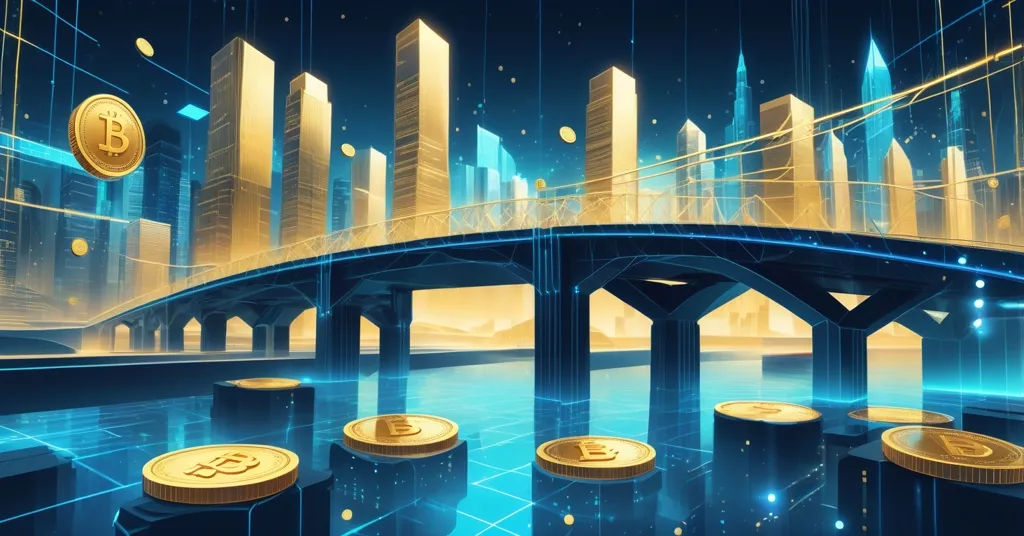Real-World Assets (RWAs): Crypto’s Stable Frontier Amid Market Volatility

Real-World Assets (RWAs): The New Frontier for Crypto Investors Amid Volatility
The crypto market remains a wild ride, with price swings that can turn even the most iron-stomached traders pale. Yet, while retail investors obsess over Bitcoin’s latest dip or the next altcoin moonshot, institutional heavyweights are quietly betting big on a more stable, transformative application of blockchain tech: real-world assets (RWAs). These tokenized versions of traditional financial instruments like U.S. Treasuries and private credit are proving that decentralized systems can do more than fuel speculative mania—they can reshape finance itself.
- Market Boom: Over $35 billion in RWAs are tokenized on-chain, with massive growth on BNB Chain and Solana.
- Institutional Push: Giants like BlackRock and Franklin Templeton are leading adoption with cutting-edge products.
- Future Outlook: McKinsey predicts a $4 trillion RWA market by 2030, despite regulatory and technical hurdles.
Understanding RWAs: Bridging Traditional Finance and Blockchain
Let’s break it down for those new to the game. Real-world assets, or RWAs, are traditional financial instruments—think government bonds, private loans, or even shares in a company—that have been digitized and tokenized on blockchain networks. Tokenization is the process of converting ownership rights of these assets into digital tokens, which can then be traded, split into fractions, or held just like any cryptocurrency. Picture owning a tiny slice of a U.S. Treasury bond without needing a brokerage account or wading through mountains of paperwork. That’s the magic of fractional ownership, akin to buying a piece of a pie instead of the whole thing. It’s accessible, efficient, and operates 24/7, unshackled from the rigid hours of legacy markets.
The numbers tell a compelling story. Data from rwa.xyz pegs the current on-chain value of RWAs (excluding stablecoins) at a hefty $35.67 billion, with private credit and U.S. Treasury debt as the standout categories. This isn’t chump change—it’s a neon sign that serious capital, often from institutional players, sees blockchain as a legitimate tool for asset management, not just a casino for degens. The appeal lies in stability and utility: unlike volatile altcoins or meme tokens, RWAs are often backed by real cash flows or collateral, offering a safer harbor in the stormy seas of crypto markets. For a deeper look into why investors are gravitating toward these assets, check out this insightful piece on investors doubling down on RWAs.
The Rise of Tokenized Assets: Explosive Growth on Key Blockchains
Some blockchains are emerging as powerhouses for tokenized real-world assets. Take BNB Chain, for example. In 2024, its total value locked (TVL)—the amount of capital committed to its protocols—surged from a modest $5 million to a staggering $1 billion in RWA-related projects. That’s not a typo, and it’s not luck. It’s driven by products from financial behemoths like Circle with its USYC token, BlackRock’s BUIDL, Franklin Templeton’s BENJI, VanEck’s VBILL, Qatari National Bank’s QCDT, and China Merchant Bank’s CMBMINT. Sarah Song, Head of Business Development at BNB Chain, nails the value proposition:
“Investors can easily switch between different types of assets directly on-chain with a 24/7 trading and investing experience based on different risk preferences under different market conditions.”
In plain English, blockchain’s always-on infrastructure lets investors pivot strategies at lightning speed, no waiting for market open or bureaucratic delays. Over on Solana, a Layer-1 blockchain prized for its low fees and high throughput, Messari reports $418.1 million in RWA value. Yield-bearing assets—tokens that generate passive income—like Ondo Finance’s OUSG and USDY (tokenized U.S. Treasuries) are gaining traction fast. For instance, USDY offers exposure to Treasury yields with an annualized return hovering around 5%, a rare blend of stability and gain in the crypto wild west. These platforms aren’t just sandboxes for tech geeks; they’re proving grounds for blockchain’s real-world utility.
Institutional Adoption: Why the Big Players Are All In
The presence of titans like BlackRock and Franklin Templeton isn’t a fluke—it’s a signal that the gap between crypto-native ecosystems and traditional finance is shrinking. BlackRock’s BUIDL, for instance, built on Ethereum but also integrated with BNB Chain, provides investors exposure to U.S. Treasuries with a reported yield near 5%. It’s not without risks—smart contract vulnerabilities could be a weak link—but it’s a clear statement of intent from one of Wall Street’s biggest names. Franklin Templeton’s BENJI token similarly offers a tokenized fund, blending legacy credibility with blockchain efficiency. When firms managing trillions in assets start playing in this space, you know it’s not just a passing trend.
Why the enthusiasm despite crypto’s notorious volatility? RWAs offer a hedge. They’re tied to assets with predictable cash flows, not the whims of Twitter hype cycles. Plus, blockchain slashes overhead—think fewer middlemen, faster settlements, and global access. Imagine a small investor in a remote region buying a $10 stake in a U.S. Treasury bond via Solana. That kind of democratization was unthinkable a decade ago, and it’s why institutional capital is flowing into blockchain RWA investments, even as Bitcoin and altcoins gyrate.
The Promise of RWAs: A Financial Revolution in the Making
Zoom out, and the potential gets even more dizzying. A June 2024 report from McKinsey & Company forecasts that the global market for tokenized real-world assets could hit $4 trillion by 2030. That’s not a typo—it’s a figure rivaling the GDP of entire nations, all living on-chain. Mike McCluskey, CEO of Sologenic, likens this to the dawn of the internet:
“What we’re actually starting to see is the beginning stages of an exponential growth curve of value moving on-chain. In the very near future, every asset will have a digital token that represents its real-world value.”
He’s not far off. Early skeptics dismissed the internet as a toy until it rewired society. Tokenization could do the same for finance, turning antiquated, siloed systems into a borderless, always-on marketplace. Think trading a fraction of a skyscraper in Dubai or a corporate bond from Tokyo at midnight on a weekend. This aligns squarely with our push for effective accelerationism—rushing headlong into tech that disrupts and includes, provided we don’t trip over our own feet.
Historical context adds weight to this optimism. Early tokenization efforts on Ethereum around 2017-2018 often flopped, bogged down by clunky tech and regulatory gray zones. Today, with better smart contract platforms and institutional backing, the momentum feels different—more grounded, less speculative. It’s not just about hype; it’s about retooling financial plumbing for the digital age.
The Dark Side: Challenges and Risks of RWAs
Before we get too starry-eyed, let’s face the ugly truth—RWAs aren’t a flawless utopia. Scaling to mainstream adoption is riddled with potholes, starting with a regulatory landscape that’s a flaming mess. Policies differ drastically between regions. In the U.S., recent moves like the Genius Act, the White House Digital Assets Working Group Report, the Clarity Act, and the Responsible Financial Innovations Act offer hope for a clearer framework. Dave Hendricks, CEO of Vertalo, points to progress on this front:
“We finally have more clarity when it comes to tokenized RWAs, especially since the most recent administration appointed new leadership at The Securities and Exchange Commission (SEC) and Commodity Futures Trading Commission (CFTC).”
But one country’s clarity is another’s chaos. Europe’s MiCA regulations aim to standardize crypto rules but lag in addressing tokenized assets specifically. Asia’s a mixed bag—Hong Kong pushes progressive policies while China clamps down hard. Navigating this global patchwork is like playing regulatory whack-a-mole, and it’s stifling cross-border innovation. Staci Warden, CEO of the Algorand Foundation, flags deeper operational risks:
“Supervisors are rightly worried about intraday liquidity, bank-run dynamics, and concentration if ‘all the collateral’ moves onto a handful of platforms faster than the safeguards do.”
Translation: if too much value piles onto a few blockchains like BNB Chain or Solana without bulletproof protections, a single hack or glitch could trigger a catastrophic domino effect. Think of it as a digital bank run, but faster and uglier. Then there’s the tech itself—interoperability, or the ability of blockchains to talk to each other and to traditional systems, remains a frustrating work-in-progress. Custody solutions for tokenized assets must be Fort Knox-level secure, and risk management needs to catch up to the unique threats of on-chain finance.
Let’s play devil’s advocate for a moment. Could RWAs, ironically, undermine the very ethos of decentralization we champion? With giants like BlackRock steering the ship, there’s a real danger of swapping Wall Street gatekeepers for blockchain-based ones. If a handful of institutions or platforms dominate tokenized assets, we’re not far from “centralized decentralization”—a paradox that should keep any privacy advocate up at night. And what about hacks? A smart contract bug in something like BUIDL could vaporize millions in seconds, shaking confidence harder than any Bitcoin crash. These aren’t just speed bumps; they’re potential dealbreakers if not tackled head-on.
Bitcoin’s Role—or Lack Thereof—in the RWA Space
As Bitcoin enthusiasts, we must address the elephant in the room: why isn’t the king of crypto leading the RWA charge? Bitcoin’s primary strength lies in being a decentralized store of value—sound money, free from meddling hands—not a platform for complex financial instruments. Its blockchain lacks the robust smart contract capabilities of Ethereum, Solana, or BNB Chain, which are better suited for tokenizing assets. That said, Layer-2 solutions like Lightning Network for faster transactions or Stacks for smart contract functionality could eventually carve a niche for Bitcoin in this space. For now, though, RWAs highlight why altcoins and other protocols fill critical gaps, even if they don’t carry Bitcoin’s ideological purity. We’re not maximalists to the point of blindness—diversity in blockchain use cases drives the broader revolution.
Some Bitcoin purists might grumble that RWAs distract from the mission of dismantling fiat systems. Fair point, but the counter is simple: tokenized assets could onboard billions into decentralized tech, indirectly bolstering Bitcoin’s relevance as a reserve asset in a digitized economy. It’s not either/or—it’s both, with each piece of the puzzle pushing against the creaky status quo.
Key Questions and Takeaways on Real-World Assets in Crypto
- What are real-world assets (RWAs) in the blockchain space?
RWAs are traditional financial instruments like U.S. Treasuries, private credit, or equities converted into digital tokens on blockchain networks. Through tokenization, they enable fractional ownership and 24/7 trading, making global markets accessible to anyone with an internet connection. - Why are institutional investors betting on RWAs despite crypto’s volatility?
Unlike speculative tokens, RWAs are tied to stable, cash-flow-backed assets, offering diversification and a safer entry into blockchain. Their efficiency—cutting out middlemen and enabling instant settlements—appeals to long-term, risk-averse capital. - What obstacles stand in the way of mainstream RWA adoption?
Fragmented global regulations, technical interoperability issues between blockchains and legacy systems, and risks like liquidity crises or hacks pose significant challenges to scaling tokenized real-world assets in crypto. - How transformative could the RWA market be for blockchain tech?
With $35.67 billion already on-chain, McKinsey projects the market for blockchain real-world assets could soar to $4 trillion by 2030, potentially cementing crypto as a cornerstone of modern finance. - Which blockchain networks are spearheading RWA growth?
BNB Chain leads with $1 billion in total value locked in RWA projects, while Solana holds $418.1 million, both hosting institutional-grade tokenized U.S. Treasuries and yield-bearing assets. - Do RWAs risk undermining decentralization in the crypto movement?
Heavy institutional involvement from firms like BlackRock could centralize control over tokenized assets, replacing old financial gatekeepers with new ones. Striking a balance between innovation and true decentralization remains a pressing debate.
A Grounded Optimism for the Future of RWAs
So, while crypto markets might still induce vertigo, real-world assets stand out as a mature, practical application of blockchain technology. They’re not immune to growing pains—regulatory tangles and tech limitations will test resolve—but the potential to overhaul financial systems is too colossal to dismiss. This isn’t about chasing quick gains or shilling baseless hype; it’s a structural shift toward efficiency, inclusion, and disruption. With the suits at BlackRock and Franklin Templeton already on board, the question looms: could RWAs be the bridge that finally drags crypto into the mainstream financial fold, or are we one misstep from a brutal reality check? Only time, and relentless innovation, will tell.



